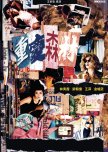A Compilation of Images Adding Up to Nothing
A movie where even the pretentiousness is unoriginal. To wit: a woman who smuggles drugs looks mysterious in a cliched trench coat and sunglasses at night. Oh, and a ludicrous blonde, bouffant wig. Why does she wear that wig? No reason. The auteur director, Wong Kar-wai, just thought it was a cool visual. Hell, at the end of this segment another woman also wears a blonde bouffant wig. Why does she wear one? Well, because the first woman wore one.
Blonde Bouffant Wig #1 kills the boyfriend of Blonde Bouffant Wig #2 who has something to do with her drug smuggling business. Why does she kill him? It seems a deal got botched, but really, who the hell knows. The movie does not trade in specifics. You see, specifics are for the vulgar, unwashed masses who want things to make sense. And our auteur director Wong Kar-wai does not make films for plebeians; he makes films for enlightened critics.
Earlier that evening Blonde Bouffant Wig #1 had bumped into a man who'd been jilted by his girlfriend, May. He eats canned pineapple with an expiration of May 1st because that's his birthday. And his girlfriend's name is May (golly, how clever of the screenwriter to have come up with this!) He eats canned pineapple every day for a month while waiting for his relationship with May to be resolved. He eats a lot of canned pineapples. He meets Blonde Bouffant Wig #1 at a bar and asks "Do you like pineapples?" as his pick up line.
This segment ends at 40 minutes. Since the director figured that was too short for a feature, he added another segment. There is certainly no organic reason for it.. The second movie is about a girl at a food stand who has a crush on a cop. He's been jilted too. She listens to the Beach Boys "California Dreaming" a lot. What is the significance of this? Nothing. But the director plays the song about a dozen times in the course of an hour (that's not hyperbole, the song literally plays every 5-10 minutes), and the excessive recurrence fools the audience into believing it's significant. Yet it's no more significant than the blonde bouffant wigs. Indeed, all that holds the movie's 2 segments together is that they both have random details posing as meaningful details. It seems to have fooled a lot of critics, who gush about this film.
It's just a compilation of images all of which add up to nothing, but empty imagery has always proven catnip for critics. You see, to use lots of nifty terminology such as "non-linear narrative." What does non-linear narrative mean, you ask? Why, it's code for "has no plot" because the director/screenwriter does not know how to construct one. Many say the movie is about loneliness, or about people getting jilted, or about modern, urban relationships. Those are pretty wide open labels that fit thousands of other films. The fact is, this auteur director has not given us any particular plot or theme. He simply knows how to shoot images. Lots and lots of images.
Blonde Bouffant Wig #1 kills the boyfriend of Blonde Bouffant Wig #2 who has something to do with her drug smuggling business. Why does she kill him? It seems a deal got botched, but really, who the hell knows. The movie does not trade in specifics. You see, specifics are for the vulgar, unwashed masses who want things to make sense. And our auteur director Wong Kar-wai does not make films for plebeians; he makes films for enlightened critics.
Earlier that evening Blonde Bouffant Wig #1 had bumped into a man who'd been jilted by his girlfriend, May. He eats canned pineapple with an expiration of May 1st because that's his birthday. And his girlfriend's name is May (golly, how clever of the screenwriter to have come up with this!) He eats canned pineapple every day for a month while waiting for his relationship with May to be resolved. He eats a lot of canned pineapples. He meets Blonde Bouffant Wig #1 at a bar and asks "Do you like pineapples?" as his pick up line.
This segment ends at 40 minutes. Since the director figured that was too short for a feature, he added another segment. There is certainly no organic reason for it.. The second movie is about a girl at a food stand who has a crush on a cop. He's been jilted too. She listens to the Beach Boys "California Dreaming" a lot. What is the significance of this? Nothing. But the director plays the song about a dozen times in the course of an hour (that's not hyperbole, the song literally plays every 5-10 minutes), and the excessive recurrence fools the audience into believing it's significant. Yet it's no more significant than the blonde bouffant wigs. Indeed, all that holds the movie's 2 segments together is that they both have random details posing as meaningful details. It seems to have fooled a lot of critics, who gush about this film.
It's just a compilation of images all of which add up to nothing, but empty imagery has always proven catnip for critics. You see, to use lots of nifty terminology such as "non-linear narrative." What does non-linear narrative mean, you ask? Why, it's code for "has no plot" because the director/screenwriter does not know how to construct one. Many say the movie is about loneliness, or about people getting jilted, or about modern, urban relationships. Those are pretty wide open labels that fit thousands of other films. The fact is, this auteur director has not given us any particular plot or theme. He simply knows how to shoot images. Lots and lots of images.
Vond je deze recentie nuttig?

 1
1



















